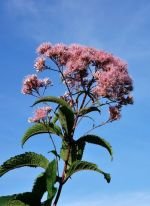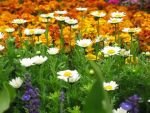Coltsfoot
Coltsfoot (Tussilago farfara)
Also known as Claywort, Coughwort, Butter Bur, Horsehoof. This is an early spring, cool season perennial that is found primarily in the north-eastern United States.
|
These flowering weeds have a similar appearance to dandelions. Flowers surface early in spring. When blooms begin to die back, weed leaves begin to grow and become fully developed in late June to mid-July. Leaves are a deep green in color with distinctive purple veins. They are thick and rubbery with rigid scalloped edges. Having a waxy appearance on top, the underside of leaves have white, fuzzy hairs. |

 |
| Photo: Barbro Rutgersson |
The shape of these leaves can appear similar to velvetleaf or cocklebur. The leaves can also resemble the appearance of a horse's hoof. This is where the name Horsehoof came to be.
This weed has no stems - a petiole branch holds flowers. Petiole is the stalk attaching the leaf to stem. Petiole has much of the same internal structure of the stem. The combination of the leaves (which grow 6-8 inches) and the flowers form a canopy that can grow anywhere from 6-18 inches.
This is a competitive weed and will grow even if mixed with other competitive weeds and grasses. Originally from Europe, North Africa and Asia, if efforts are not made to eradicate weed it will eventually take over, even displacing native species. This weed grows in colonies and will survive in bad soils even where a lot of gravel is present, like roadsides.
It spreads by seed and rhizome. For removal dig weed out. Other options include cut back with a hoe or mow over it if present in lawn. Remember these latter methods will require regular management.
Opinions on various non-selective post-emergent herbicides differ as to effectiveness. Glyphosate comes in first as being the most effective.
FYI tidbits about Coltsfoot
Although used for medicinal purposes, this weed is noxious and never should be ingested because of toxic compounds. Studies concluded different findings as far as weed being carcinogenic.
If not a knowledgeable herbalist, it is highly recommended to never experiment at all with this weed. If in your garden - eradicate it.
Related Articles:
Back from Coltsfoot to home page Easy Butterfly Garden
 Copyright © 2010-2015 Easy-Butterfly-Garden.com
Copyright © 2010-2015 Easy-Butterfly-Garden.com
Privacy Policy Disclaimer
 Print Print
|

Join Easy Butterfly Garden on Facebook
Recent Articles
-
Daylillies
Sep 27, 15 12:13 PM
Daylillies attract all kinds of butterflies and are a very durable plant, even in winter. Cultivers come in different forms and colors. As beautiful as they are, there is one drawback...
-
Joe Pye Weed
Sep 13, 15 02:11 PM
Joe pye weed looks great in a more casual garden setting. It's not considered invasive but between the many seeds and the fast growing rhizome system, it needs to be controlled.
-
Daisy Flower
Aug 30, 15 03:37 PM
The up-side to the daisy flower is that it is up when the sun is feeding pollinators. The down side is that one particualar species is invasive.
-
This Gardening and Butterfly Websites Sitemap
Aug 16, 15 11:34 PM
This gardening and butterfly websites sitemap for easier navigation.
-
Calliopsis
Aug 16, 15 11:28 PM
Calliopsis is a name shared by other flowering plants in the Asteraceae familiy. These include Tickseed and the Coreopsis perennial.





New! Comments
Have your say about what you just read! Leave me a comment in the box below.